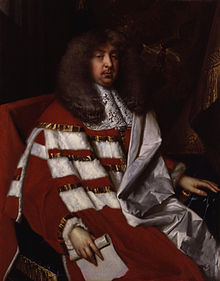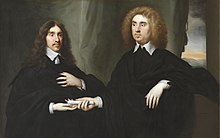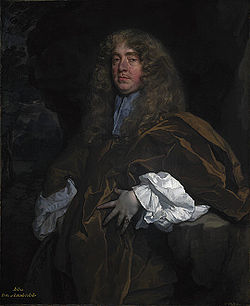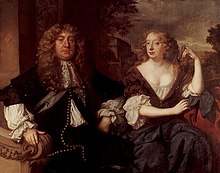Wikipedia
This text was copied from Wikipedia on 14 January 2025 at 6:10AM.
The Duke of Lauderdale | |
|---|---|
 Portrait by Jacob Huysmans | |
| Lord High Commissioner | |
| In office 2 August 1669 – October 1680 | |
| Monarch | Charles II |
| Preceded by | Earl of Rothes |
| Succeeded by | Duke of Albany |
| Secretary of State | |
| In office 19 January 1661 – October 1680 | |
| Monarch | Charles II |
| Preceded by | William Kerr, 1st Earl of Lothian |
| Succeeded by | Earl of Middleton |
| Personal details | |
| Born | 24 May 1616 Lethington Castle, East Lothian, Scotland |
| Died | 24 August 1682(1682-08-24) (aged 66) Tunbridge Wells, Kent, England |
| Resting place | St Mary's Collegiate Church |
| Spouse(s) | Lady Anne Home Elizabeth, Countess of Dysart |
John Maitland, 1st Duke of Lauderdale, KG, PC (24 May 1616 – 24 August 1682) was a Scottish statesman and peer.
Background
Maitland was a member of an ancient family of both Berwickshire and East Lothian, the eldest surviving son of John Maitland, 2nd Lord Maitland of Thirlestane (d. 1645), (who had been created Viscount of Lauderdale in 1616, and Earl of Lauderdale etc., in 1624), and of Lady Isabel (1594–1638), daughter of Alexander Seton, 1st Earl of Dunfermline and great-grandson of Sir Richard Maitland of Lethington, the poet.[1]
Covenanter
Maitland began public life as a zealous adherent of the Presbyterian cause, took the Covenant, sat as an elder in the General Assembly of the Church of Scotland at St Andrews in July 1643, and was sent to the Kingdom of England as a Commissioner for the Covenant in August, and to attend the Westminster Assembly in November.[1]
Privy Councillor in two kingdoms
In February 1644 he was a member of the Privy Council of England and the Privy Council of Scotland, and on 20 November was one of the Commissioners appointed to meet the king at Uxbridge, when he made efforts to persuade King Charles I to agree to the establishment of Presbyterianism. In 1645 he advised Charles to reject the proposals of Independents, and in 1647 he was in London when the Scottish Estates in Edinburgh ordered the king's surrender to the Scots.[1]
Second English Civil War and the Worcester Campaign

Once Charles surrendered to the Scots, Lauderdale veered round completely to the king's cause, had several interviews with him, and engaged in various projects for his restoration, offering the aid of the Scots, on the condition of Charles's consent to the establishment of Presbyterianism, and on 26 December he obtained from Charles at Carisbrooke Castle "The Engagement" by which Presbyterianism was to be established for three years, schismatics were to be suppressed, and the acts of the Parliament of Scotland ratified, the king in addition promising to admit the Scottish nobles into public employment in England and to reside frequently in Scotland.[1]
Returning to Scotland, in the spring of 1648, Lauderdale joined the party of Hamilton in alliance with the English royalists. Their defeat at the Battle of Preston, postponed the arrival of the Charles, Prince of Wales, but Lauderdale had an interview with the prince in the Downs in August, and from this period obtained supreme influence over the future king. He persuaded Prince Charles later to accept the invitation to Scotland from Archibald Campbell, Marquess of Argyll's faction, accompanied him thither in 1650 and in the expedition into England, and was captured following the Battle of Worcester in 1651.[1] He escaped from the city in the company of the Earl of Derby and Duke of Buckingham, but they were taken prisoner near Newport in Shropshire.[2]
Interregnum

Lauderdale remained in confinement from his capture at Worcester until March 1660.[1] He was exempted from Cromwell's Act of Grace under which his estates were confiscated by Oliver Cromwell the Lord Protector. This was fortunate for him, because confiscated estates were restored to their owners, while land sales to pay fines were not reversed at the Restoration.
Restoration
Just before the restoration, he joined Charles II in May 1660 at Breda, the Netherlands, and in spite of the opposition of Edward Hyde, 1st Earl of Clarendon and George Monck, was appointed Secretary of State for Scotland.[1]
King's councillor
From this time onwards he kept his hold upon the king, was lodged at Whitehall, was "never from the king's ear nor council",[3] and maintained his position against his numerous adversaries by a crafty dexterity in dealing with men, a fearless unscrupulousness, and a robust strength of will, which overcame all opposition. Though a man of considerable learning and intellectual attainment, he was authoritarian and determined to implement the King's instructions.
He abandoned Argyll to his fate, permitted, if he did not assist in, the restoration of episcopacy in Scotland, and after triumphing over all his opponents in Scotland drew into his own hands the whole administration of that kingdom, and proceeded to impose upon it the absolute supremacy of the crown in Kirk and state, restoring the nomination of the lords of the articles to the king and initiating severe measures against the Covenanters. In 1669 he was able to boast with truth that "the king is now master here in all causes and over all persons".[1]
The Cabal Ministry


His own power was now at its height, and his position as the favourite of Charles II, controlled by no considerations of patriotism or statesmanship, and completely independent of the English parliament, recalled the worst scandals and abuses of the Stuart administration before the English Civil War.[1]
He was a member of the Cabal Ministry, but took little part in English affairs, and being a Presbyterian was not entrusted with the first secret Treaty of Dover, but gave personal support to Charles in his degrading demands for pensions from Louis XIV. On 2 May 1672 he was created Duke of Lauderdale and Earl of March, and on 3 June Knight of the Garter.[1]
In 1673, on the resignation of James, Duke of York in consequence of the Test Act, he was appointed a Lord Commissioner of the Admiralty. In October he visited Scotland to suppress the dissenters and obtain money for the Third Anglo-Dutch War. The intrigues organised by Anthony Ashley-Cooper, 1st Earl of Shaftesbury, against his power in his absence, and the attacks made upon him in the House of Commons in January 1674 and April 1675, were alike rendered futile by the steady support of Charles and James.[1]
On 25 June 1674 he was created Earl of Guilford and Baron Petersham in the Peerage of England. His ferocious measures having failed to suppress the conventicles in Scotland, he summoned to his aid in 1677 a band of Highlanders, who were sent into the western country. In consequence, a large party of Scottish nobles went to London, made common cause with the English Country Faction, and compelled Charles to order the disbandment of the marauders. In May 1678 another demand made in the Commons for Lauderdale's removal was defeated due to court influence, by a margin of only a single vote.[4]
He maintained his triumphs almost to the end. In Scotland, which he visited immediately after this victory in the Parliament of England, he overbore all opposition to the king's demands for money. Another address for his removal from the Commons in England was suppressed by the dissolution of parliament on 26 May 1679, and a renewed attack upon him, by the Scottish party and Shaftesbury's faction combined, also failed. Later that summer on 22 June 1679 the last attempt of the Covenanters was suppressed at the Battle of Bothwell Brig.[5]
Resignation
Following a stroke or heart attack early in 1680, his health and abilities failed leading Lauderdale to resign in October that year the place and power for which he had so long successfully struggled. His vote given for the execution of Lord Stafford on 29 November incurred the displeasure of the Duke of York.[5]
Personal life

Lauderdale's first marriage was to Lady Anne Home, daughter of Alexander Home, 1st Earl of Home and Mary (Dudley) Sutton, by whom he had one daughter, Mary who married John Hay, 2nd Marquess of Tweeddale.[5]
In 1672, after his wife's death in Paris he married Elizabeth, Countess of Dysart in her own right, daughter of William Murray, 1st Earl of Dysart, and now widow of Sir Lionel Tollemache. Among his stepchildren was General Thomas Tollemache. He left no male heir, consequently his dukedom and his English titles became extinct, but he was succeeded in the earldom by his brother Charles Maitland, 3rd Earl of Lauderdale.[5]
See also
References
- ^ a b c d e f g h i j k Yorke 1911, p. 279.
- ^ Paterson, Raymond Campbell. King Lauderdale: The Corruption of Power. John Donald, 2003. p. 114.
- ^ Yorke 1911, p. 279 cites: Samuel Pepys Diary, 2 March 1664.
- ^ Yorke 1911, pp. 279, 280.
- ^ a b c d Yorke 1911, p. 280.
Sources
- Airy, Osmund (1885–1900). . Dictionary of National Biography. London: Smith, Elder & Co.
- Marshall, Rosalind K. (2004). "Murray, Elizabeth, duchess of Lauderdale and suo jure countess of Dysart (bap. 1626, d. 1698)". Oxford Dictionary of National Biography. Oxford University Press. doi:10.1093/ref:odnb/19601.
- Maitland, John (1884). Airy, Osmund (ed.). The Lauderdale Papers (1639-1667). Vol. 1. London: Camden Society. Retrieved 6 August 2019.
- Maitland, John (1885a). Airy, Osmund (ed.). The Lauderdale Papers (1667-1678). Vol. 2. London: Camden Society. Retrieved 6 August 2019.
- Maitland, John (1885b). Airy, Osmund (ed.). The Lauderdale Papers (1673-1679). Vol. 3. London: Camden Society. Retrieved 6 August 2019.
Attribution
- This article incorporates text from a publication now in the public domain: Yorke, Philip Chesney (1911). "Lauderdale, John Maitland, Duke of". In Chisholm, Hugh (ed.). Encyclopædia Britannica. Vol. 16 (11th ed.). Cambridge University Press. pp. 279–280.
Further reading
DNB - The chief authorities for Lauderdale's life are:
- Baillie's Letters and Journals;
- Burnet's Lives of the Dukes of Hamilton, and Hist. of his own Time;
- Mackenzie's Memoirs;
- Wodrow's Hist. of the Sufferings of the Church of Scotland;
- the Hamilton Papers, published by the Camden Society;
- and especially the vast collection of the Lauderdale Papers in the manuscripts room at the British Museum, three volumes of selections from which have also been issued by the Camden Society
The EB article lists the following sources:
- Lauderdale Papers Add. manuscripts in Brit. Mus., 30 vols., a small selection of which, entitled The Lauderdale Papers, were edited by Osmond Airy for the Camden Society in 1884–1885;
- Hamilton Papers published by the same society;
- "Lauderdale Correspondence with Archbishop Sharp," Scottish Hist. Soc. Publications, vol. 5 (1893);
- Burnet's Lives of the Hamiltons and History of his Own Time;
- R Baillie's Letters;
- SR Gardiner's Hist. of the Civil War and of the Commonwealth;
- Clarendon's Hist. of the Rebellion;
- The Quarterly Review, civii. 407. Several speeches of Lauderdale are extant.

10 Annotations
First Reading
Phil • Link
"2nd Earl of Lauderdale, cr. Duke 1672 (1616-82)" according to the L&M Companion. during the period of the diary he was Secretary for Scottish Affairs.
Paul Brewster • Link
Wheatley footnote:
John Maitland, second Earl, and afterwards created Marquis of March, Duke of Lauderdale and Earl of Guilford (in England), and K.G. He became sole Secretary of State for Scotland in 1661, and was a Gentlemen of his Majesty's Bedchamber, and died in 1682, s.p. (sine prole, Without offspring)
Pedro. • Link
For good summary and picture see…
http://en.wikipedia.org/wiki/John…
Second Reading
Bill • Link
In 1649 he opposed with great vehemence the propositions made by the marquise of Montross to king Charles II ; and in 1651 attended his majesty in his expedition into England, but was taken prisoner after the battle of Worcester in Sept. the same year, and confined in the Tower of London, Portland-castle, and other prisons, till March 3, 1659-60, when he was released from his imprisonment in Windsor-castle. Upon the restoration he was made secretary of state for Scotland, and persuaded the k. to demolish the forts and citadels built by Cromwell in Scotland; by which means he became very popular. He was likewise very importunate with his majesty for his supporting presbytery in that kingdom; though his zeal in this respect, did not continue long. In 1669 he was appointed lord commissioner for the k. in Scotland.
---Bibliotheca biographica. Thomas Flloyd, 1760.
Bill • Link
The duke of Lauderdale, who had been employed in several treaties in the late reign, and had been a sufferer in the cause of Charles II. was highly in favour with that prince. He was thought, before the Restoration, and especially during his imprisonment after the battle of Worcester, to have had some sense of religion; but his conduct afterwards was utterly inconsistent with every social and religious principle. He taught the king the political maxim of "neglecting his friends, and making friends of his enemies." His whole system of politics was much of the same cast. When he was high-commissioner in Scotland, he enslaved his country by every mode of oppression: he loaded it with taxes, ruined its trade, plundered its inhabitants, and persecuted its religion. When the people were grown mad by his cruelty, he obstructed the course of justice, and blocked up every avenue to the throne. He was one of those who were employed in forging chains for the English, and who will ever be remembered by the name of the Cabal. He was servile and imperious, haughty and abject; was a man of great learning, but aukward and ungainly in speech and behaviour. He practised all the arts of cunning and dissimulation to gain power, and was the barefaced tyrant after he had gained it. Ob. 24 Aug. 1682.
---A Biographical History of England. J. Granger, 1769.
San Diego Sarah • Link
"He was one of those who were employed in forging chains for the English, ..." Can anyone explain this reference to chains for the English? Chains for the Scots, I can understand. For instance:
Richard "Hannibal" Rumbold made his defiant declaration on the Edinburgh scaffold before his execution for being part of the Rye House Plot on 26 June 1685: “This is a deluded generation, veiled in ignorance, that though popery and slavery be riding in upon them, do not perceive it; though I am sure that there was no man born marked by God above another; for none comes into this world with a saddle on his back, neither any booted and spurred to ride him...” This speech was rendered famous all over again during the discussions on the definition of treason at the American Constitutional Convention.
But this 1685 reference to slavery doesn't implicate Lauderdale, who was long gone by then anyways.
I've been unsuccessfully searching my files for the reference to the freeing of English slaves (whites, not indians or blacks), I recall by Charles II, except for miners who had to continue their miserable existence, from generation to generation. As I recall at least some of these miners were Scots.
Maybe it's a general reference to the brutality with which Judge Jeffries et al handled anyone who was inconvenient, and Lauderdale was a dab hand at that, even though he did take the trouble to have Charles II confirm every course of action before he took it. It was a brutal time, with or without chains.
Bill • Link
MAITLAND, JOHN, second Earl and first Duke of Lauderdale (1616-1682), grandson of Sir John Maitland; grand-nephew of William Maitland of Lethington; regarded as a rising hope of the ultra-covenanting party; commissioner for the Solemn League and Covenant, 1643-6; one of the commissioners who obtained the famous 'Engagement'; with Charles II in Holland, 1649; followed him to Worcester and was taken prisoner, 1651; kept a prisoner till 1660; secretary for Scottish affairs, 1660-80; aimed at making the crown absolute in Scotland both in state and church; had complete influence over Charles; created Duke of Lauderdale and Marquis of March in the Scottish peerage, 1672; placed upon the commission for the admiralty, 1673; made a privy councillor and a peer of England as Earl of Guildford and Baron Petersham, 1674: supported by Charles II against attacks from the English parliament.
---Dictionary of National Biography: Index and Epitome. S. Lee, 1906.
San Diego Sarah • Link
John Maitland, Duke of Lauderdale, was unfortunate that his enemies included the two best historical sources of information on the late 17th century – Gilbert Burnet and Chancellor Edward Hyde, Earl of Clarendon. They detested him, and their commentaries have been taken by subsequent writers as an accurate account of his character and abilities.
The facts are more complex.
John Maitland started his political career in 1638, just back from his studies in the Calvinist city of Geneva, by signing the Covenant which called on King Charles to respect the decisions of the Scots Parliament and of the general assembly of the Church.
He continued as a Covenanter, commanded a regiment of cavalry at the Battle of Marston Moor in the Parliamentary army in 1644 and represented the Kirk in London until 1645.
Then, after the Scots had sold their King to the English Parliament, and realizing the Charles I’s life was in danger, John Maitland, now 2nd Earl of Lauderdale, became a Royalist.
Lauderdale’s conversion to the royal cause was a defining moment, and a guide to his character. He became a royalist to protect his King, not to gain personal advantage – the King was a prisoner and could give him nothing. His support put him in conflict with the Kirk, and finally into an English prison, with all his estates confiscated.
When released from Windsor just before the Restoration, the Earl of Lauderdale could not buy a pair of boots.
At the Restoration in 1660, Charles II rewarded Lauderdale with political advancement as the Secretary of State for Scotland, and the recovery of his estates. For 12 years until 1672 he was a skilled and efficient politician who took advantage of the political atmosphere of the restoration era and ensured Charles’ policies were implemented.
His career declined as Charles II’s policy of war with Holland in 1672 aroused opposition. Parliament and opponents became more assertive, and Lauderdale had no parliamentary management skills.
The Popish Plot in 1679 shook the monarchy, and Lauderdale was no longer able to keep order in Scotland. This failure led to his supersession, and the collapse of his health led to his resignation. He had retained Charles II’s confidence for an unparalleled 20 years, whilst other ministers rose and fell. Some fled the country, others went to prison.
Twenty years is a long period of office for any politician, and Lauderdale was successful for the bulk of it.
San Diego Sarah • Link
PART 2
His enemies described John Maitland, Duke of Lauderdale as an uncouth oaf, although they conceded his scholarship: He was literate in English, French, Latin, Greek and Hebrew.
His taste in furnishing, art and architecture was impeccable.
He married Elizabeth Murray Tollemache, the Countess of Dysart in her own right, and a wealthy and beautiful widow who was free to choose any man at the glittering Caroline court, and could have succeeded at the court of Louis XIV at Versailles if she had wanted to.
He cannot have been an oaf.
But there is no doubt he used course language. The words “arse” and “fart” are frequently quoted in his conversations.
After his marriage in 1672, John Maitland, Duke of Lauderdale's character deteriorated, possibly due to the influence of his wife (as people believed at the time), or to the advance of disease – kidney stones are painful.
In addition to a high income, the Duchess used her position to sell influence in conjunction with Lauderdale's nephew, Charles Maitland and corruption (a common practice at the time) was rampant.
Overall, Lauderdale was a man of conscience who supported King Charles at a time when this was of no advantage for him, who risked his life and suffered imprisonment for Prince Charles, and advised him as Charles II from 1649 until 1680 – 31 years, and who held office for an unparalleled 20 years after the Restoration.
He was ruined in King Charles I’s service, and repaired his fortunes as a minister to Charles II. Educated and cultivated, he had a rough side, but was one of the most able men of his generation.
Excerpted from https://clanmaitland.uk/history/c…
San Diego Sarah • Link
For a look at John Maitland, Duke of Lauderdale's home, much enlarged by Elizabeth Murray Tollemache Maitland, Countess of Dysart and Duchess of Lauderdale, see
https://www.thirlestanecastle.co.…
What a dining room!
CORRECTION: This site tells me that Charles Maitland was the younger brother of John, and not his nephew. Charles went on to be the 3rd Earl of Lauderdale as the Dukedom died with John in August 1682.